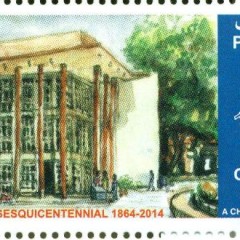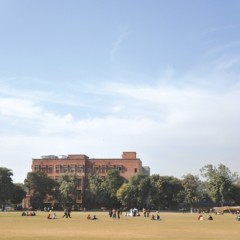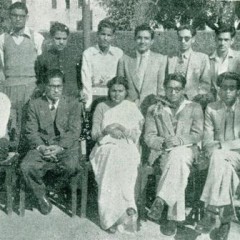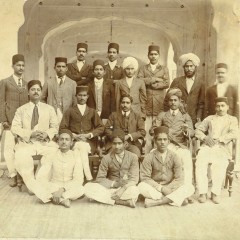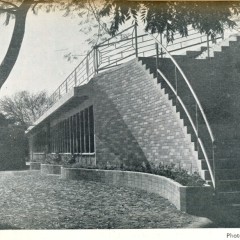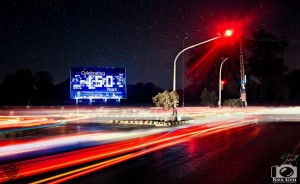Pakistan Post issues stamp commemorating FCC’s 150th anniversary
On Wednesday 14 May 2014, Pakistan Post issued a stamp highlighting FCC’s sesquicentennial. For those who don’t want to go to the GPO, panes of 15 stamps are now available from Ms Eileen Dass’s office at the cost of Rs 150. Pak Post has also issued a first day cover and an accompanying leaflet, shown below. A limited number of first day covers will be available for sale from Tuesday 20 May 2014. Here is an extract from the leaflet: “To commemorate the great achievements of FCC, in its sesquicentennial year, Pakistan Post is issuing a stamp which depicts Sinclair Hall, constructed to mark the centenary of FCC and completed in 1971. Named after a devoted principal, Dr EJ Sinclair, who served FCC for over fifty years as a faculty member and from 1962-1968 as Principal, the building was designed by architect Nasreddin Murat Khan who also designed the Minar-e-Pakistan. One of the most recognisable buildings on campus, the depiction is by watercolour artist Anjum Zaheer. As FCC celebrates its 150th anniversary in 2014, it is proud of the legacy it has inherited and aware of the responsibility this places on it as educators of the youth of Pakistan, and indeed the region.”...
Here’s To Another 150 Years
by Moaz Ahmed Here’s to another 150 years of glory of the FC College. Luckily my freshman year at FC College is the year of its 150th anniversary, which is nothing short of a remarkable achievement. The key to happiness in life, I used to believe, was to have blind faith in yourself and in God and in that good things will happen to you. This belief of mine became all the more intact when I became a Formanite. From my orientation day with the legend Ms Cheryl Burke to every day for the rest of my life, FC College will always be the best thing that ever happened to me. I grew up a dreamer. I would watch massive universities in films, with thousands of students, hostels, literally cities within cities. Such was the kind of university I dreamed of being a part of. And just stepping into FC College gave me the instant realization that not only would this hundred plus acres fulfill my dream, but would also be home to all my future dreams. And that is exactly what happened. I have always been a dreamer. I dream that FC College goes on glorifying the lives of thousands for another 150 years and more, as it has and as it will continue doing so. So here’s to every Formanite that is out there. Here’s to the thousands of trees and birds of FC College. Here’s to the Lucas Center, the Susheela Building, the Armacost Building. Here’s to all the alumni. Here’s to another 150...
An Interview with Enver Sajjad
Polymath Dr Enver Sajjad was a student at Forman Christian College in the 1950s. The following are translated excerpts from an interview he gave to FCC students for the Golden Jubilee issue of Folio magazine in 1985. Q: Your personality needs no introduction, but despite this we would like you to introduce yourself in your own words. A: My name is Enver Sajjad. In 1951 I failed my FSc at Government College and got admission in FC College. I did my BSc also from FC College. I passed my MBBS from Kind Edward Medical College and nowadays I run a clinic. Q: Did you take part in extracurricular activities at college? A: Yes, I was the Secretary General of the College Union, I was the editor of the college magazine, and took part in all sorts of activities. Q: Do you take pride in having been the editor of the college magazine? A: Yes, I’m proud of having been the editor of FC College’s magazine, the magazine of which Krishan Chander and other well-known authors of the subcontinent have also been editors. Q: Despite being a medical student, you took a very active part in other activities. How did you balance these two? A: This is a matter of temperament and of intention. If you really intend to do something then you find the time to do so. Q: Did you feel there was any difference between FC College and other colleges? A: In the same way that the people of a country make it good or bad, this is true of educational institutions too. In this respect I really liked FC College because the teachers were very good and they really supported the growth of the students. In my own growth Professor Baswas, Professor Farzand Ali and Dr Khairaat ibne-Rasa (who was also our warden) played a very big part. Q: Which teacher impressed you the most? A: All of them impressed me because I used to argue with all of them, ask questions of all of them, and mix with all of them. Q: Would you like to become a student again? A: I am still a student. Q: When did you start writing? A: I started writing in 1949-50. Q: Who was your model when you started writing? A: All of them were my ideals, I liked them all. Manto especially impressed me. Q: When did you start writing plays? A: I started when I was still at Government College. Actually I learnt the A-B-Cs of playwriting at Government College and its grammar at FC College. In the beginning I used to translate from English to...
Random Reflexions of a Formanite (1911-13)
By Dr K L Moudgill MA (Cantab), DSc (Glasgow), DSc (Travancore) Deputy Director (Chemicals) Indian Standards Institution Following my three brothers who had graduated from the Forman Christian College, I joined in 1911 and studied there for two years. The Ewing era had blossomed to its height and the Forman College dominated the educational filed in Lahore. The Government College was there, but generally sore that the Formanites used to steal the thunder in the Punjab University. The cricket and the football trophies had been won by our Alma Mater and re-donated, with the name of the college coupled with that of the original donors as a proof of its prowess in the playing fields. In our days, Dr J. C. R. Ewing was sometimes spoken of as Jhelum Chenab Ravi Ewing. Did this rather childish invention of the undergraduate mind in some manner foretell the final destiny of the college? Of the five rivers of the Punjab (not to speak of the mighty Indus) the College now bestows its special benefits to the youth nurtured on the soil fertilized by the three whose names were misquoted as the initials of the famous Principal. Dr Wilson was then young, in fact very young. Dr Lucas had married Miss Nancy Ewing and, otherwise, established himself as the coming leading light of the College. Mr Samuels Lall was an ardent admirer of the quiz system by which he used to give black marks to errant youth who could not prove the Binomial Theorem on the class blackboard when called upon to do so without notice. Later, after his illness, he became much too mild and managed to get more work done by his loving ways than the terror of his black mark system. Dr Griswold was another saint whom all students loved, though they concocted numerous stories about his absent-mindedness. Mr Benade joined as a Professor. I sat in his classes sometimes. At other times, he thought I was there! Horrible confession, perhaps! Mechanics, the subject dreaded and shunned by the Intermediate students, was the only part of Physics that had not been covered by Dr Flemming, Mr Benade’s predecessor. Instead of attending lectures, the approaching University Examination lured us to the calm and quiet of the Lawrence Gardens where we prepared for the Examination on a sumptuous mid-day meal of bhatooras, ganderis and oranges. The sophisticated modern term “Luncheon” was not known in those days and “Tiffin” was eaten only by Sahib Lok. But I suppose the youth of today is no different from what it was in my days. It may be said to Mr Benade’s credit that he always...
1963: The Controversial Student Centre
The Lucas Centre is so much a part of the life of FCC students nowadays, that they probably don’t realize that its architecture was a source of controversy when it was first built in 1963. The following is an extract from an article by faculty member Mr Stanley E Brush: The structure nearing completion (as of early February, 1963) in the physical education sector of the Forman Christian College campus has the distinction of having been praised and condemned already in the strongest terms possible by the large number of amateur critics who have observed the growth of the building. Adverse reactions go so far as to compare it with a third class waiting hall or a stable. Favourable comments are inclined to reflect as unrestrained a response on the other side. It would be safe to say, at the least, that the appearance of the building has not passed unnoticed. The concept of the Lucas Student Centre originated in the Report of the Commission on National Education with its emphasis on the need for developing facilities for students on a larger scale than has hitherto existed. The willingness of the Government of Pakistan to make funds available made it possible to bring this multipurpose building into existence, while the creative planning and design of the Engineering Department of the United Christian Hospital, under the guidance of its head, Mr Le Young, gave form to the vaguely conceived ideas of the college planners. The movement from concept to completion is almost finished. Mr Young has designed a building that provides the Physical Education Department with an outdoor gymnasium, playing court, shower and locker rooms and an office. Part of the building houses community service facilities, such as barbering, tailoring, cycle repairing and a book and stationery shop. Refreshment rooms will be confined to a tea shop and fruit shop for the present, although further expansion is possible which would include a full cafeteria system dining room and kitchen. Student and staff lounges and further office space are included. Finally, the roof has been designed as a tiered stadium for both the athletic playing field in front of the Centre and the enclosed gymnasium within. Lighting has been provided for night games and functions. The design of the Centre is the major point of controversy. The person who has seen the building may be somewhat startled by the claim that the design does conform to the standard set by Mughal architecture and follows some of its major principles, if these are accepted as consisting of a sense of austerity, formality, balance, colour and, finally, the architectural value of sincerity. With...

